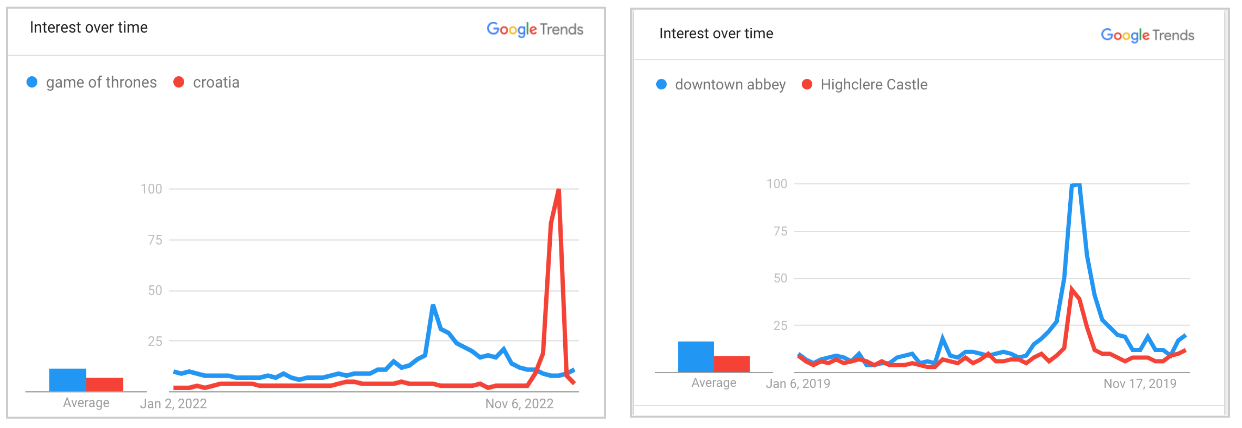Binge-Watching is the new Travel Influencer
A Story of Escapism and Exploration
Binge-watching has become as much a part of popular culture as wanderlust. Both offer their own (in some sense) unique ways of exploring new places, cultures, and experiences. Watching travel shows or TV series set in stunning locations, I began to wonder: Does the inspiration drawn from these shows actually fuel a desire among viewers to visit these destinations? Is binge watching materially shaping the places people travel to and the way they travel?
Has binge-watching become the travel influencer we all needed ?
As you immerse yourself in the enchanting world of "Game of Thrones", you find yourself drawn to the breathtaking backdrop of Dubrovnik, Croatia, and the lure of the King's Landing beckons. You're not alone – thousands of other viewers share your fascination, propelling Dubrovnik to new heights in tourism. In a similar vein, the majestic Highclere Castle in England, home to the Crawley family in "Downton Abbey," witnessed an unprecedented surge in visitors, all thanks to the magic of storytelling.
Unlike travel influencers who often present a meticulously curated and idealized version of their experiences, TV shows and movies offer an immersive narrative that goes beyond mere aesthetics. They delve into the heart and soul of the destinations, exploring local customs, history, and societal nuances. This unfiltered view sparks a genuine curiosity among viewers, igniting the desire to experience these locations firsthand.
I began to search for concrete data.



Evidence # 1: Google Trends have some good insights
A quick search on Google Trends reveals a fascinating pattern: a surge in interest for specific destinations corresponding to the popularity of their on-screen representations. Bypassing the anomalous years of 2020 and 2021, we can discern a direct correlation between the viewing habits of audiences and their subsequent travel choices.
Evidence # 2: Surveys and Secondary Research show promising data
According to Expedia, 40% of travelers now draw inspiration from movies and TV shows, surpassing the influence of social media at 31%. Furthermore, the small screen is now considered on par with recommendations from friends and family when it comes to travel inspiration. [Source]
In the United States, 68% of travelers considered visiting a destination they saw on screen, with 61% actually booking a trip. [Source].
Netflix series like "Emily in Paris," "Lupin," and "Marseille" have cast a spell on viewers, spurring a renewed interest in French tourism. [Source]
Below is some additional research highlighting key factors driving film driven tourism.

Evidence # 3 : And Finally, Follow the Money, Always (or Location Placement in this context)
Tourism boards and local governments have taken notice of the significant impact that TV shows and movies have on their regions. For instance, Dubrovnik reaped $220 million in economic activity from the filming of "Game of Thrones," while Albuquerque garnered $140 million from "Breaking Bad."
Local governments are increasingly offering financial incentives, tax breaks, or other support to production companies to film in their regions, which serves as a form of location placement or location scouting.
Examples: The Scottish government provided “Outlander'“ millions of dollars in funding to help secure the production of the TV show in Scotland. Northern Ireland Screen, the national screen agency for Northern Ireland, provided financial support (approximately $21.4 million) to the production of the Game of Thrones series.
So, to wrap up
The relationship between binge-watching and travel is a fascinating one. Fictional stories and characters intertwine with the reality of tangible locations, making the audience yearn for adventures to places they've never been. Whether it is the sun-kissed Mediterranean landscapes in "The Trip to Greece," the charming cobbled streets of Paris in "Emily in Paris," or the rugged, sweeping vistas of New Zealand in "The Lord of the Rings" trilogy, these visual feasts invite viewers to embark on their own journeys.

